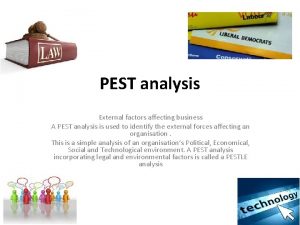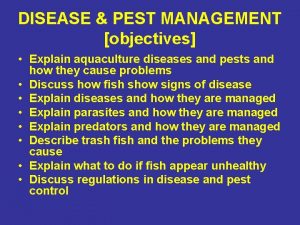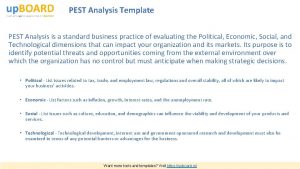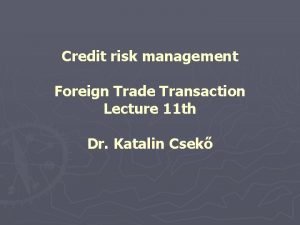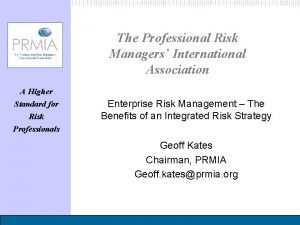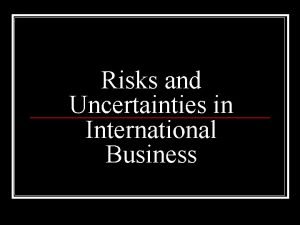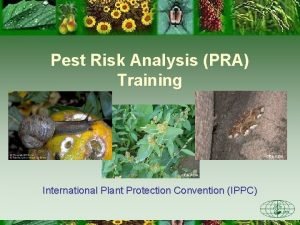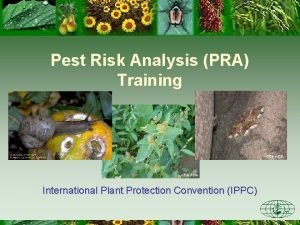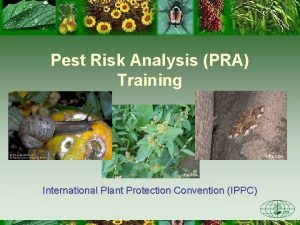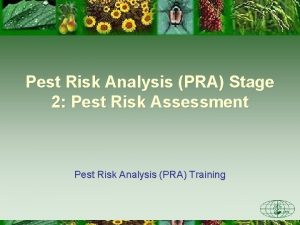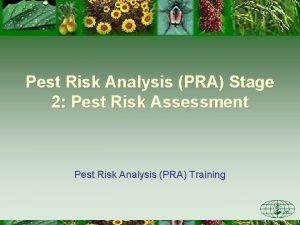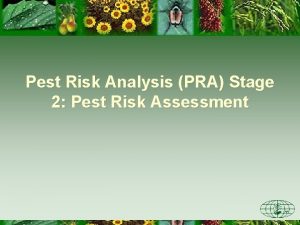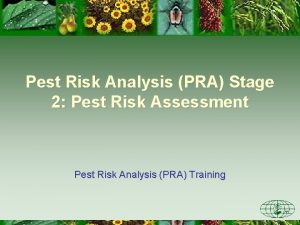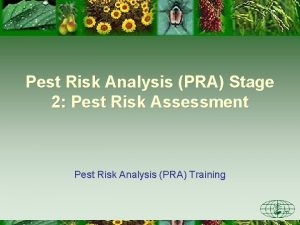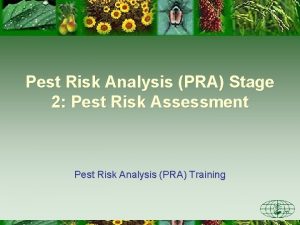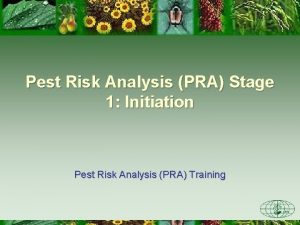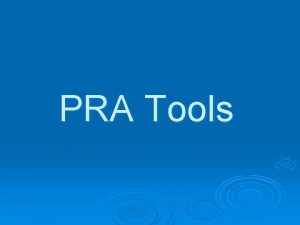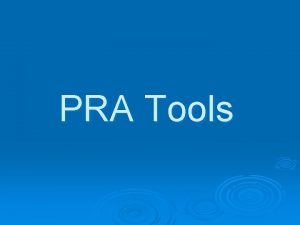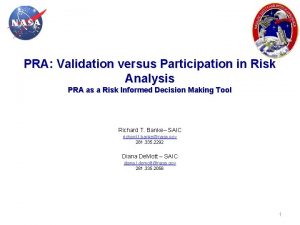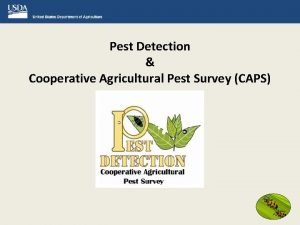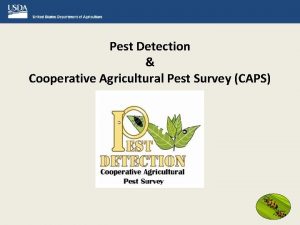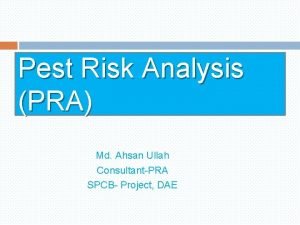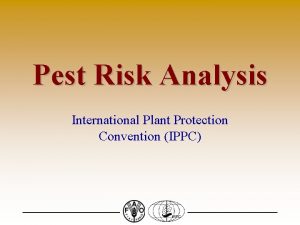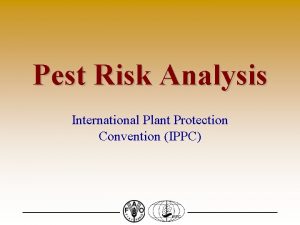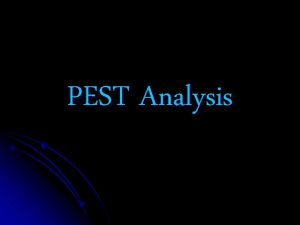Pest Risk Analysis PRA Training CFIAACIA International Plant





























- Slides: 29

Pest Risk Analysis (PRA) Training CFIA-ACIA International Plant Protection Convention (IPPC)

International Steering Committee

Aims • Provide participants with an understanding of the purpose of PRA • Develop skills to conduct PRA • Provide hands-on experience in PRA • Provide international examples • Develop self-confidence in PRA

Course Materials • • Participant’s Manual Group Exercise Manual Slides and Presentations Manual International Standards for Phytosanitary Measures No. 1 -24

What to Expect • Lectures and Discussions • Practical Exercises • Interactive • Provide your input

The International Plant Protection Convention (IPPC) Pest Risk Analysis (PRA) Training

Outline • The Convention (IPPC) • Scope • Key Principles • Standard setting

Outline • The Convention (IPPC) • Scope • Key Principles • PRA Standards

What is the IPPC? • Multilateral treaty for international cooperation in plant protection – Nearly 160 countries – From Albania to Zambia • A standard setting organization

Aim of the IPPC • Prevent introduction & spread of pests • Promote fair & safe trade • Protect plant life

Scope of the IPPC • IPPC covers wide range of plants & protects them from a wide range of pests – plants: cultivated plants and wild flora – plant pests: invertebrates, diseases and weeds – harm: includes direct & indirect effects

Scope of the IPPC • Extends to items capable of harbouring or spreading pests, such as: – storage places – conveyances • Includes intentional introductions of organisms, such as: – biological control organisms – research, industrial or other organisms

Key principles • Countries have the right to use phytosanitary measures • Measures should be: – – – only applied when necessary technically justified no more restrictive than necessary to address risk non-discriminatory transparent

Obligations • National Plant Protection Organization (NPPO) • Regulate imports • Publish phytosanitary requirements • Conduct surveillance, treatments and certify exports • Share information on pests and regulations • Notify trading partners of non-compliance

International Plant Protection Convention Plant protection & safe trade Transparent All types of plants All types of pests Other pathways Justified IPPC Consistent with level of risk

World Trade Organization (WTO) • Responsible for establishing rules of trade between nations • IPPC is the recognized international standard setting body for plant health under the WTO-SPS

WTO - SPS Agreement Phytosanitary measures should be: – consistent with international standards – justified by scientific principles and evidence – harmonized to the extent possible – transparent / notified / non-discriminatory – only as restrictive as necessary to meet the appropriate level of protection

International regulatory framework IPPC The IPPC makes provision for trade in a plant protection agreement. . . SPS …the SPS makes complementary provisions for plant protection in a trade agreement

Other international agreements • Convention on Biological Diversity (CBD) – Protecting biodiversity – Invasive alien species – Cartagena Protocol on Biosafety • Genetically modified organisms

International regulatory framework IPPC Protecting biological diversity Plant protection SPS Trade CBD LMOs Cartagena Protocol

International regulatory framework Plant protection No more trade restrictive than necessary IPPC LMOs identified as pests CP SPS Protecting wild flora CBD LMOs Biological diversity Trade while protecting biodiversity

Focus on IPPC Commission on Phytosanitary Measures Standards Setting Information Sharing IPPC Secretariat Expert Working Groups Technical Panels Technical Assistance

Commission on Phytosanitary Measures (CPM) • Governing body for the IPPC, works by consensus • Reviews global plant protection needs and sets the annual work programme • Develops and adopts International Standards for Phytosanitary Measures (ISPMs) • Promotes technical assistance and information exchange

International Standards for Phytosanitary Measures (ISPMs) ISPMs: • provide guidance to member countries in implementing national programs and fulfilling requirements of the IPPC • may be very general (e. g. , Glossary, Principles etc. ), or highly specific (e. g. , Pest status, Solid wood packaging etc. )

Diversity of ISPMs Specific Issues General Guidelines No. 6 – surveillance No. 17 – pest reporting No. 23 - inspection No. 1 – principles No. 5 – glossary of terms No. 19 – pest lists Country Consultation in 2006 Debarked & bark-free wood Low pest prevalence for fruit flies Treatments for regulated pests

PRA • Key to adhering to IPPC principles is application of pest risk analysis as a decision-making process • Impacts on all aspects of phytosanitary programs: import, domestic programs, exports • Guidance provided in ISPMs

PRA-specific ISPMs • ISPM No. 2 – Framework for pest risk analysis, revision for approval by CPM in March 2007 • ISPM No. 3 – Guidelines for the export, shipment, import and release of biological control agents and other beneficial organisms, 2005 • ISPM No. 11 – Pest risk analysis for quarantine pests including analysis of environmental risks and living modified organisms, 2004 • ISPM No. 21 – Pest risk analysis for regulated non-quarantine pests

PRA-specific ISPMs • ISPM No. 2 – Framework for pest risk analysis (2007) • ISPM No. 3 – Guidelines for the export, shipment, import and release of biological control agents and other beneficial organisms, 2005 • ISPM No. 11 – Pest risk analysis for quarantine pests including analysis of environmental risks and living modified organisms, (2004) • ISPM No. 21 – Pest risk analysis for regulated non-quarantine pests

IPPC • IPPC is global • Aim is to protect plants, prevent spread of pests, promote trade • Measures applied only when necessary, technically justified, no more restrictive than necessary, non-discriminatory, transparent • PRA supports principles of IPPC • ISPMs provide guidance
 Market risk assessment
Market risk assessment External factors affecting tesco
External factors affecting tesco Aquaculture pest analysis
Aquaculture pest analysis Pest analysis template
Pest analysis template C-pest analysis for an event
C-pest analysis for an event Scope of plant breeding
Scope of plant breeding Taichum
Taichum Plant introduction in plant breeding
Plant introduction in plant breeding Tronsmo plant pathology and plant diseases download
Tronsmo plant pathology and plant diseases download Tronsmo plant pathology and plant diseases download
Tronsmo plant pathology and plant diseases download Tronsmo plant pathology and plant diseases download
Tronsmo plant pathology and plant diseases download Risk projection
Risk projection Risk management avoidance
Risk management avoidance Absolute risk vs relative risk
Absolute risk vs relative risk Residual risk and secondary risk pmp
Residual risk and secondary risk pmp Tracing vs vouching
Tracing vs vouching Absolute risk vs relative risk
Absolute risk vs relative risk Activity sheet 1 how diversified are these portfolios
Activity sheet 1 how diversified are these portfolios Firm risk scorecard risk classification system
Firm risk scorecard risk classification system Pembiayaan risiko (risk financing)
Pembiayaan risiko (risk financing) The biggest risk is not taking any risks
The biggest risk is not taking any risks Key risk indicators for vendor management
Key risk indicators for vendor management Ir x cr x dr
Ir x cr x dr Business risk and financial risk leverage
Business risk and financial risk leverage Attributable risk formula
Attributable risk formula Risk map risk management
Risk map risk management Measure of association formula
Measure of association formula Credit risk in international trade
Credit risk in international trade Professional risk managers international association
Professional risk managers international association Natural risks in business
Natural risks in business

